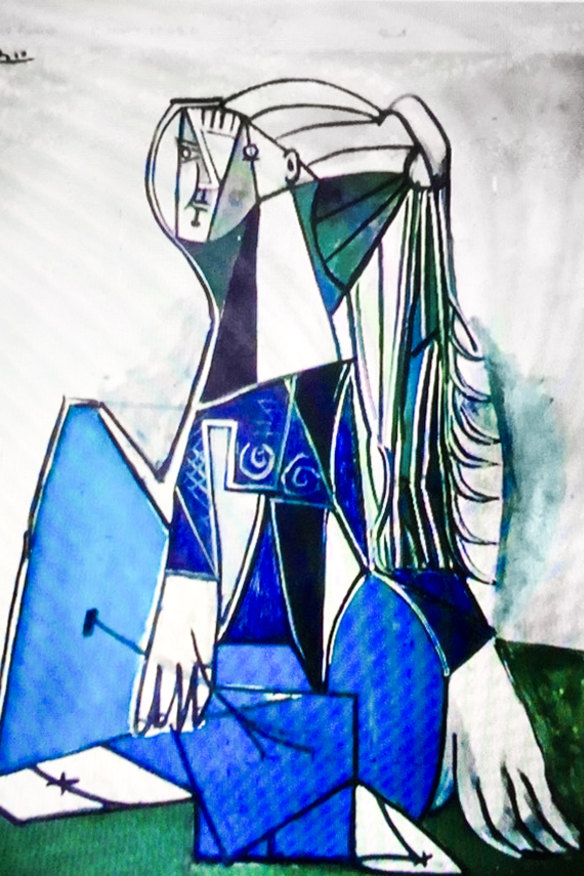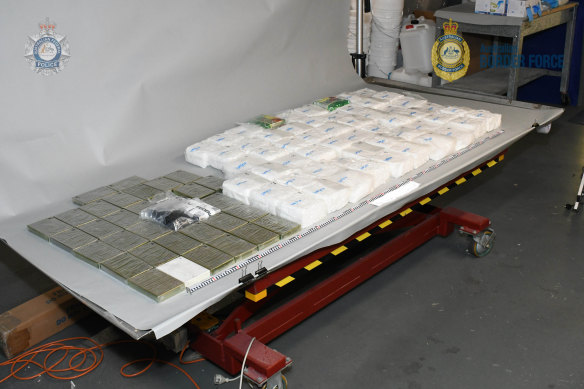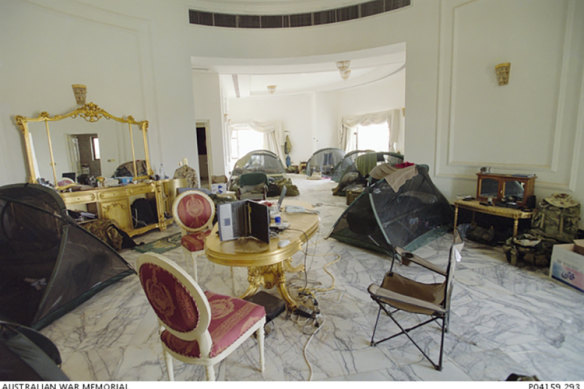Art
‘Saddam Hussein’s Picasso’: Drug kingpin wanted to launder money but instead got a fake
The shadowy nature of the art market makes it ripe for exploitation by organised criminals, sparking calls for a shake-up of money-laundering and provenance rules.
The tale of the Picasso painting looted from Saddam Hussein’s palace had enough of a ring of truth to convince the ruthless Melbourne underworld figure to hand over $500,000 in a wild bid to launder his drug money.
The cubist portrait of a woman dressed in blue had supposedly been stolen by Australian soldiers occupying one of the dictator’s opulent homes after the fall of Baghdad in 2003. Not only was it apparently signed by Pablo Picasso, but the frame still had a decades-old label from a Parisian gallery that had once possessed it.

Smuggled back to Australia, the painting had been kept hidden until a buyer could be found that was willing to risk an investment of hundreds of thousands of dollars to potentially one day reap a windfall of millions if it could be authenticated and then traded in the legitimate art market.
The kingpin, who cannot be named for legal reasons because he is currently facing criminal charges over a large-scale drug trafficking operation, had so much dirty money in need of a wash that he considered the dubious Picasso “investment” worth the risk.
Ultimately, the broker disappeared with the $500,000 as the Picasso was set to be smuggled to France to be authenticated. Experts who viewed a photograph of the painting obtained by The Age suggested strongly it was a fake.
But this didn’t stop the erstwhile underworld investor, who would try again when offered long-shot chances to conceal his criminal profits using other paintings by Picasso and French master Henri Matisse, which also had distinctly dubious origins.
“You can’t send a million dollars using DHL. The artwork gives them massive amounts of money in a DHL parcel,” an underworld source involved in the art trade said. “[These paintings can be] sent overseas in carry-on luggage. [A painting is] better than bitcoin.”
The shadowy nature of the art market has left it ripe for exploitation by organised criminals, who have added paintings, sculptures and non-fungible tokens (NFTs) to their list of underworld currency and laundering tools, much like property, jewels, cars, luxury goods, casinos and cryptocurrencies.
“These groups are always looking for new ways to try and conceal this money,” Detective Inspector Jennifer Locke from Victoria Police’s criminal proceeds squad said.
“We regularly see syndicates where those involved have purchased designer clothing and accessories or expensive jewellery, and artworks just provide another option for offenders.”
“These criminal syndicates are run like businesses and artworks represent a business investment.”
‘An ideal way to hide money’
When Victoria Police and federal law enforcement authorities dismantled the drug empire of the Melbourne-based Notorious Crime Family last year, investigators uncovered signs that the gang was also running a sophisticated sideline in the art trade.

Five artworks by well-known Australian artists Brett Whiteley, Adam Cullen, Ben Quilty and Fred Williams – worth nearly $900,000 – were found among a more than $47 million portfolio of ill-gotten assets that also included numerous properties, Rolex watches and a yacht.
Police suspect the NCF drug syndicate was using “cleanskins” – associates without prior criminal convictions – as intermediaries to allegedly convert drug profits into high-value artworks purchased from a legitimate Melbourne art gallery.
Organised crime is attracted to art dealing because it is a largely unregulated market where high-value assets can be traded between anonymous parties and paid for in large sums of cash.
Paintings are also harder to identify as proceeds of crime by law enforcement. A painting found hanging inside a home or professionally wrapped and stored could be an investment or inherited from a relative.
“It’s an ideal way to hide money, to sit on it. Art is easily hidden, easily traded but hard to trace,” said a detective who specialises in investigating organised crime, who cannot be identified speaking about police operations.
“The art market can be easily infiltrated by organised criminals yet is a lot more respectable than crypto and subtler than amassing huge piles of unexplainable cash or boats and cars.”
Convicted murderer George Marrogi, the founder of the collapsed NCF syndicate, is suspected to have paid for the artworks in cash through an art dealer and a lawyer, keeping his identity as the buyer hidden.
Current money laundering and terrorism financing laws do not regulate art dealers and auction houses, despite a recommendation to expand the legislation to include high-value dealers as part of a statutory review 10 years ago.
“No one can sell a house without it being properly documented. Same with a car. But for a painting, anyone can say anything about a painting,” art market and forgery expert Professor Robyn Sloggett said.
“The law is so thin in this area, so ineffective. It’s perfect for money laundering because there are no checks and balances, no regulations around records, no regulation around the veracity of information.”
Criminal infiltration of the legitimate art industry sometimes extends to the corruption of dealers, who have been found running sophisticated international money laundering operations, according to former Australian Federal Police officer and money laundering expert Chris Douglas, of Malkara Consulting.
“The important characteristic of art is the value is in the eye of the beholder. There is no comparable market value.”
Douglas said one method was for criminals to pay above the odds for a piece of art to an accomplice dealer, who banks the cash along with funds from other legitimate sales and then transfers the money internationally under the rubric of buying more art for their gallery.
“The money’s offshore and you’ve got an alibi about why. Finding the painting is easy. But if they’re laundering by co-mingling of funds, it’s very, very hard to detect.”

While Australia had had its fair share of art “cowboys” in the past, art adviser and valuer Catherine Asquith, a former Melbourne gallerist, said that contrary to popular belief, the art market wasn’t totally unregulated or ignorant of the risks and how to manage them.
“This is not the Wild West and you will be caught out if you do the wrong thing,” she said. “We’re a small market and not much can transpire without being subjected to some level of scrutiny.”
She said other markets around the world, including New York and London, were mulling anti-money laundering measures to protect the market, but no meaningful steps had been taken in Australia.
“I think we do need to consider that at some point,” Asquith said. “Part of your due diligence should be checking where the funds are coming from if the client is not known to you and you don’t have a long-standing client relationship with them.”
But barrister Edward Greaves, who specialises in proceeds-of-crime actions, said expanding the legislation to include art dealers wouldn’t necessarily be effective in protecting the market, especially when deals can easily be conducted privately.
“Art will always be attractive to organised crime, who typically enjoy conspicuous consumption,” said Greaves.
“You’ve got to remember that someone who’s got a million dollars of dirty money will be quite happy to spend some of it to be able to keep the balance in a way that makes it look legitimate.”
Fake it ’til you make it
With the risks criminals are prepared to take to clean massive volumes of dirty money, it’s no surprise they are also susceptible to fake artworks.
The international and Australian art markets are riddled with fakes, from the work of the old European masters to local up-and-coming artists.
Forgery expert Sloggett said entrapping buyers with a fake artwork involves crafting a convincing story that could be partially fact-checked.
“All successful ruses have a grain of truth in them. Something that can be found in the public domain that’s a bit off centre. Something that has the aura that it must be insider knowledge. People get tantalised by the idea they’ve got inside information,” Sloggett said.

As for Saddam Hussein’s Picasso, the believability of the story hinged on exploiting two facts that could be used to spin out the tale.
The first was that Picasso was famously prolific, creating something like 13,500 paintings and 100,000 prints and engravings by the time of his death at 91 in 1973.
The second was that Australian troops had occupied one of Hussein’s palaces in Baghdad following the fall of the regime in 2003, at a time when the chaos of the invasion had seen widespread looting of Saddam’s network of luxurious palaces and Iraqi museums and cultural institutions.
Adding to the lustre of the story was that other reputed Picassos had been “discovered” or “recovered” in Iraq under murky circumstances on at least two occasions – the latest during a police drug raid near the border with Iran last year.
“Forgers, or people who work with forgers to pass forged works, can be pretty sophisticated at one level and pretty easy to unpick and pretty dumb at another level,” Sloggett said. “They come unstuck when they try to pass [the forgeries] to the next party without securing a story about provenance.”
Provenance is the ownership history of an artwork, from the studio of the artist who created it to its current holder (whether that might be a museum, gallery, auction house or private investor).
It determines the “pedigree” of an artwork – and how much it might sell for in the market – but there is currently no register or database that accredits the ownership of art pieces.
For example, Hussein’s Picasso came with a label on the back of the frame that purported to show it once passed through the hands of a Paris art gallery.
An alleged 1943 Matisse the Melbourne drug kingpin was also attempting to authenticate included accompanying documents emblazoned with Iranian government emblems, university stamps and the logo for a children’s cancer charity.
It remains unknown whether anything that passed through the hands of this gangland player was legitimate.
“When it comes to money, people want to believe,” an underworld source said.

Art
Calvin Lucyshyn: Vancouver Island Art Dealer Faces Fraud Charges After Police Seize Millions in Artwork

In a case that has sent shockwaves through the Vancouver Island art community, a local art dealer has been charged with one count of fraud over $5,000. Calvin Lucyshyn, the former operator of the now-closed Winchester Galleries in Oak Bay, faces the charge after police seized hundreds of artworks, valued in the tens of millions of dollars, from various storage sites in the Greater Victoria area.
Alleged Fraud Scheme
Police allege that Lucyshyn had been taking valuable art from members of the public under the guise of appraising or consigning the pieces for sale, only to cut off all communication with the owners. This investigation began in April 2022, when police received a complaint from an individual who had provided four paintings to Lucyshyn, including three works by renowned British Columbia artist Emily Carr, and had not received any updates on their sale.
Further investigation by the Saanich Police Department revealed that this was not an isolated incident. Detectives found other alleged victims who had similar experiences with Winchester Galleries, leading police to execute search warrants at three separate storage locations across Greater Victoria.
Massive Seizure of Artworks
In what has become one of the largest art fraud investigations in recent Canadian history, authorities seized approximately 1,100 pieces of art, including more than 600 pieces from a storage site in Saanich, over 300 in Langford, and more than 100 in Oak Bay. Some of the more valuable pieces, according to police, were estimated to be worth $85,000 each.
Lucyshyn was arrested on April 21, 2022, but was later released from custody. In May 2024, a fraud charge was formally laid against him.
Artwork Returned, but Some Remain Unclaimed
In a statement released on Monday, the Saanich Police Department confirmed that 1,050 of the seized artworks have been returned to their rightful owners. However, several pieces remain unclaimed, and police continue their efforts to track down the owners of these works.
Court Proceedings Ongoing
The criminal charge against Lucyshyn has not yet been tested in court, and he has publicly stated his intention to defend himself against any pending allegations. His next court appearance is scheduled for September 10, 2024.
Impact on the Local Art Community
The news of Lucyshyn’s alleged fraud has deeply affected Vancouver Island’s art community, particularly collectors, galleries, and artists who may have been impacted by the gallery’s operations. With high-value pieces from artists like Emily Carr involved, the case underscores the vulnerabilities that can exist in art transactions.
For many art collectors, the investigation has raised concerns about the potential for fraud in the art world, particularly when it comes to dealing with private galleries and dealers. The seizure of such a vast collection of artworks has also led to questions about the management and oversight of valuable art pieces, as well as the importance of transparency and trust in the industry.
As the case continues to unfold in court, it will likely serve as a cautionary tale for collectors and galleries alike, highlighting the need for due diligence in the sale and appraisal of high-value artworks.
While much of the seized artwork has been returned, the full scale of the alleged fraud is still being unraveled. Lucyshyn’s upcoming court appearances will be closely watched, not only by the legal community but also by the wider art world, as it navigates the fallout from one of Canada’s most significant art fraud cases in recent memory.
Art collectors and individuals who believe they may have been affected by this case are encouraged to contact the Saanich Police Department to inquire about any unclaimed pieces. Additionally, the case serves as a reminder for anyone involved in high-value art transactions to work with reputable dealers and to keep thorough documentation of all transactions.
As with any investment, whether in art or other ventures, it is crucial to be cautious and informed. Art fraud can devastate personal collections and finances, but by taking steps to verify authenticity, provenance, and the reputation of dealers, collectors can help safeguard their valuable pieces.
Art
Ukrainian sells art in Essex while stuck in a warzone – BBC.com
[unable to retrieve full-text content]
Ukrainian sells art in Essex while stuck in a warzone BBC.com

Source link
Art
Somerset House Fire: Courtauld Gallery Reopens, Rest of Landmark Closed
The Courtauld Gallery at Somerset House has reopened its doors to the public after a fire swept through the historic building in central London. While the gallery has resumed operations, the rest of the iconic site remains closed “until further notice.”
On Saturday, approximately 125 firefighters were called to the scene to battle the blaze, which sent smoke billowing across the city. Fortunately, the fire occurred in a part of the building not housing valuable artworks, and no injuries were reported. Authorities are still investigating the cause of the fire.
Despite the disruption, art lovers queued outside the gallery before it reopened at 10:00 BST on Sunday. One visitor expressed his relief, saying, “I was sad to see the fire, but I’m relieved the art is safe.”
The Clark family, visiting London from Washington state, USA, had a unique perspective on the incident. While sightseeing on the London Eye, they watched as firefighters tackled the flames. Paul Clark, accompanied by his wife Jiorgia and their four children, shared their concern for the safety of the artwork inside Somerset House. “It was sad to see,” Mr. Clark told the BBC. As a fan of Vincent Van Gogh, he was particularly relieved to learn that the painter’s famous Self-Portrait with Bandaged Ear had not been affected by the fire.
Blaze in the West Wing
The fire broke out around midday on Saturday in the west wing of Somerset House, a section of the building primarily used for offices and storage. Jonathan Reekie, director of Somerset House Trust, assured the public that “no valuable artefacts or artworks” were located in that part of the building. By Sunday, fire engines were still stationed outside as investigations into the fire’s origin continued.
About Somerset House
Located on the Strand in central London, Somerset House is a prominent arts venue with a rich history dating back to the Georgian era. Built on the site of a former Tudor palace, the complex is known for its iconic courtyard and is home to the Courtauld Gallery. The gallery houses a prestigious collection from the Samuel Courtauld Trust, showcasing masterpieces from the Middle Ages to the 20th century. Among the notable works are pieces by impressionist legends such as Edouard Manet, Claude Monet, Paul Cézanne, and Vincent Van Gogh.
Somerset House regularly hosts cultural exhibitions and public events, including its popular winter ice skating sessions in the courtyard. However, for now, the venue remains partially closed as authorities ensure the safety of the site following the fire.
Art lovers and the Somerset House community can take solace in knowing that the invaluable collection remains unharmed, and the Courtauld Gallery continues to welcome visitors, offering a reprieve amid the disruption.
-

 News5 hours ago
News5 hours agoMK-ULTRA: Ottawa, health centre seek to dismiss Montreal brainwashing lawsuit
-

 News16 hours ago
News16 hours agoWorld Junior Girls Golf Championship coming to Toronto-area golf course
-

 News16 hours ago
News16 hours agoMan dead after fall from balcony as police carry out Toronto search: SIU
-

 Health5 hours ago
Health5 hours agoHealth Canada approves updated Moderna COVID-19 vaccine
-

 Business17 hours ago
Business17 hours agoPolitics likely pushed Air Canada toward deal with ‘unheard of’ gains for pilots
-

 Sports4 hours ago
Sports4 hours agoFledgling Northern Super League adds four to front office ahead of April kickoff
-

 News6 hours ago
News6 hours agoCanadanewsmedia news September 17, 2024: Bloc wins Montreal Liberal stronghold
-

 News5 hours ago
News5 hours agoOttawa threatens to pull funds for Chignecto Isthmus if N.B., N.S. don’t partner





















